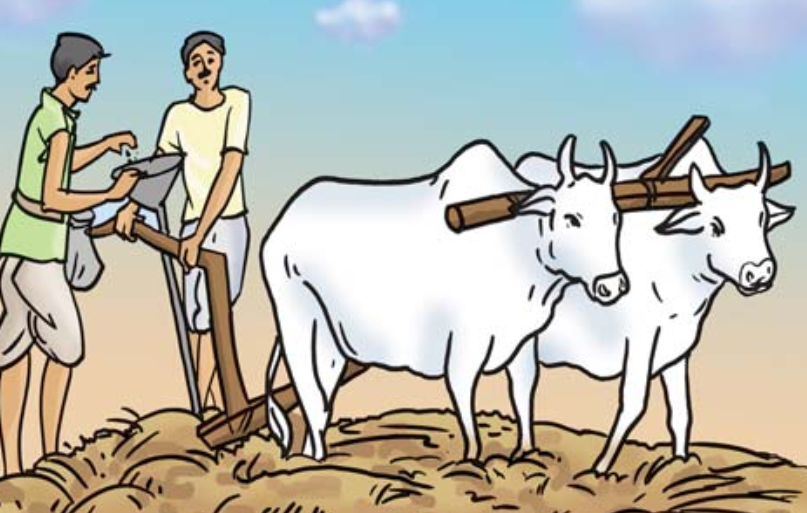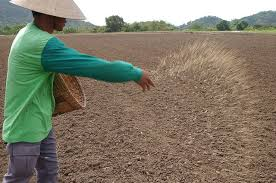Science > Biology > Management of Crop Production > Sowing of Seeds
Sowing of seeds is the most important part of crop production. This is the second step in crop production. Once the soil preparation is done, it is now time to sow the selected seeds. Sowing is the actual process of planting the seeds in the soil. Before sowing, good quality seeds are selected. Good quality seeds are clean and healthy seeds of a good variety. Farmers prefer to use seeds which give a high yield.
Selection of Seeds:
The traditional method of selecting seeds is floatation segregation. Seeds are taken in vessel and water is added to it. Damaged seeds become hollow and are thus lighter. Therefore, they float on water. This is a good method for separating good, healthy seeds from the damaged ones.
Criteria of Selection of Seeds:
For obtaining a healthy crop, healthy seeds should be used. The seeds that are used to cultivate new crops have to be selected very carefully and of high quality. For this following criteria should be used.
- Select whole seeds. Broken or crushed seeds should be avoided.
- Seeds should have a high germinating capacity.
- Germinating period of seeds should be shorter.
- Seeds should be free from infection.
- Seeds should be disease-resistant.
- They should give high yields.
- Sowing quality of seeds should be high.
- Seeds should be that of one crop only. They should not contain seeds of weeds or other seeds.
- Seeds certified by a competent agency should be used.
- Seeds should be purchased from a reliable and good shop.
Care to be Taken During Sowing of Seeds:
- Seed used for sowing should be clean, healthy and free from any disease or infection. In order to avoid the seed-borne diseases, the seeds may be treated with fungicides.
- The seeds should be sown at the right depth in the soil suitable for germination. If the seeds are just scattered on the surface of the soil, they might be picked up by birds. On the other hand, if the seeds are buried too deep, they may not get sufficient oxygen required for respiration and hence may not germinate.
- The seeds should be sown at proper spacing so that the plants germinated from them can get sufficient nutrients, water, and sunlight.
- The seeds should not be sown in dry soil or too wet soil. If soil is dry, the seeds may not germinate due to lack of moisture (water) which is essential for germination. If soil is too wet he seeds may not be able to respire properly. On drying, the surface of wet soil becomes very hard and hence it obstructs the growth of plumule.
Methods of Sowing Seeds:
Seed Dropping Behind Plough:
A man drops seeds in the furrow behind the plough through a funnel. Sowing behind the plough can be done by a device known as malobansa. It consists of a bamboo or metal tube provided with a funnel-shaped mouth. One man drops the seeds through the funnel and another man, handles the plough and the bullocks.

It is used for seed like maize, gram, peas, wheat, and barley. This is a slow and laborious method.
Broadcasting:
Broadcasting is one of the oldest and most common methods of seed sowing. This method is common in agriculturally backward areas. In this method, seeds are sprinkled or thrown in a random manner in the cultivated field. The seeds may or may not be covered with soil. Soon after broadcasting the seeds must be covered by planking or some other devices. Broadcasting may be done manually or through the mechanical spreader. When broadcasting is done manually, uniformity of seed depends upon the skill of the man. Wheat, maize, and paddy are sown by this method.

Advantages of Broadcasting:
- This method is cheap, time-saving
- It is suitable for small-seeded and crops where plant to plant distance is small or does not matter.
Disadvantages of broadcasting
- Seed distribution is uneven i.e. there is no uniformity in land coverage. Sometimes it may result in clusters of seeds on the field. Hence mechanization becomes difficult.
- Seeds may or may not be covered by soil.
- There is a chance of seed wastage.
- There are uneven planting depth and density, which results in uneven germination and uneven growth of the plant.
- Subsequent operations such as weeding, spraying, harvesting become difficult.
Dibbling
Dibbling is the process of placing seeds in holes made at equal predetermined distances and depths in the seedbed and covering them. In this method, seeds are placed in holes made at definite depth at fixed spacing. This is done by dibbler, planter or manually. Dibbler is a conical instrument used to make proper holes in the field. This is a very time-consuming process, so it is not suitable for small seeds. Most vegetables are sown in this way.

Advantages of Dibbling:
- It facilitates the practice of conservative tillage and reduces the chances of soil erosion.
- It requires fewer seeds and it gives rapid and uniform germination with good seedling vigour.
- The further processes of weeding and harvesting become easy.
- The maintenance of the crop becomes easy.
Disadvantages of Dibbling:
- It is a more laborious, time consuming and expensive process compared with broadcasting.
- If all seeds are not placed at a uniform depth, then it may result in uneven germination and uneven growth of the plant.
Drilling
Drilling consists of dropping the seeds in furrow lines in a continuous flow and covering them with soil. Drilling is done with seed drill or seed-cum-fertilizer drill. Rows can be set according to requirements. This method is very helpful in achieving proper depth, proper spacing and a proper amount of seed to be sown in the field. Drilling can be done by
- Sowing behind the plough
- Bullock pulled seed drills
- Tractor drawn seed drills.

Advantages of Seed Drills:
- Seed drill sows the seeds uniformly at a proper distance and correct depths.
- Quantity of seeds required is less.
- Driller sows the seeds at equal distances in one or more rows.
- Drilling ensures that seeds get covered by the soil after sowing as a result of which seeds cannot be picked by birds.
- Manures, fertilizers, and amendments can be applied with seeds during drilling.
- It results in rapid germination and uniform plant population per unit area.
- Sowing by using a tractor joined with seed drill saves time and labor.
Disadvantages of Seed Drills:
- It is a time-consuming process.
- It requires more labor and high cost.
Transplanting
Transplanting consists of preparing seedlings in the nursery under ideal conditions and then planting these seedlings in the prepared field. It is commonly done for vegetable and flowers. It is a very time-consuming operation. Equipment for placing plants in the soil is called transplanter. It is used for small-seeded crops like rice, tomato, onion, chili, and brinjal.

Advantages of Transplanting:
- As the plants are raised in a nursery in the initial stage, the field can be used for taking another crop during this period. Thus it helps multi-cropping.
- As the plants are raised in the nursery under controlled conditions extra care can be provided for specific seedlings.
Check row planting:
It is a method of planting, in which row-to-row and plant-to-plant distance is uniform. In this method, seeds are planted precisely along straight parallel furrows. The rows are always in two perpendicular directions. A machine used for check row planting is called check row planter.

